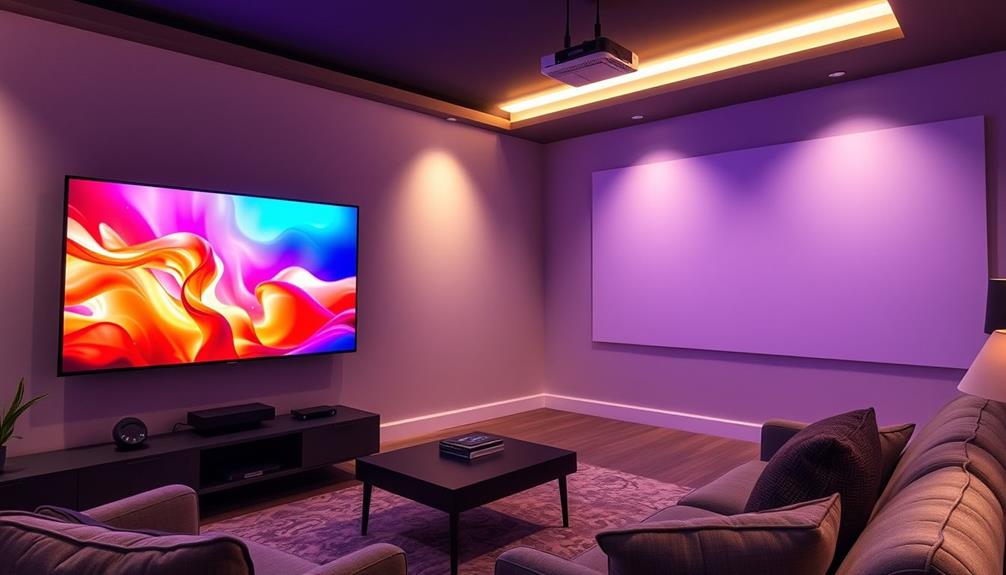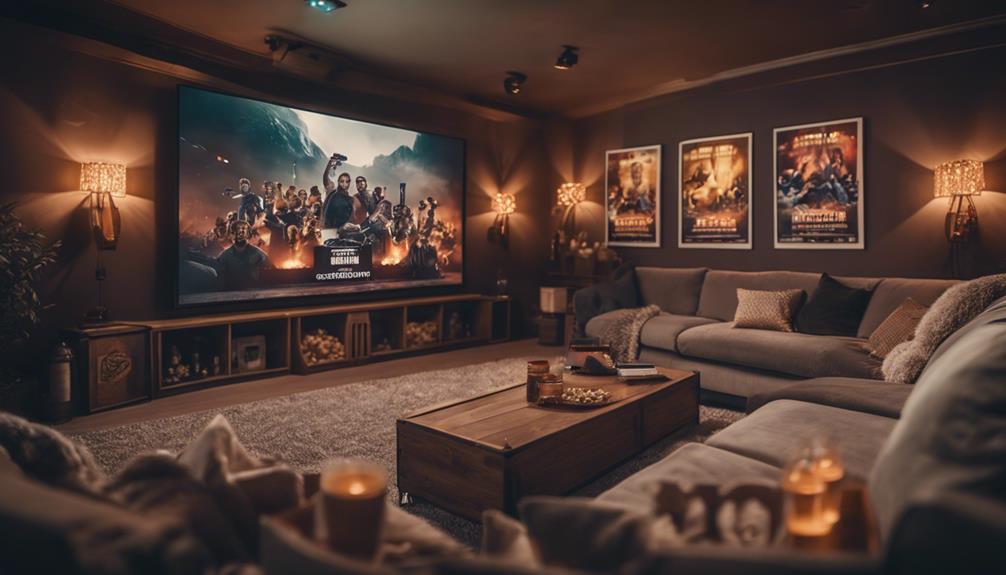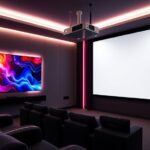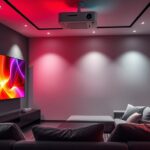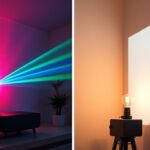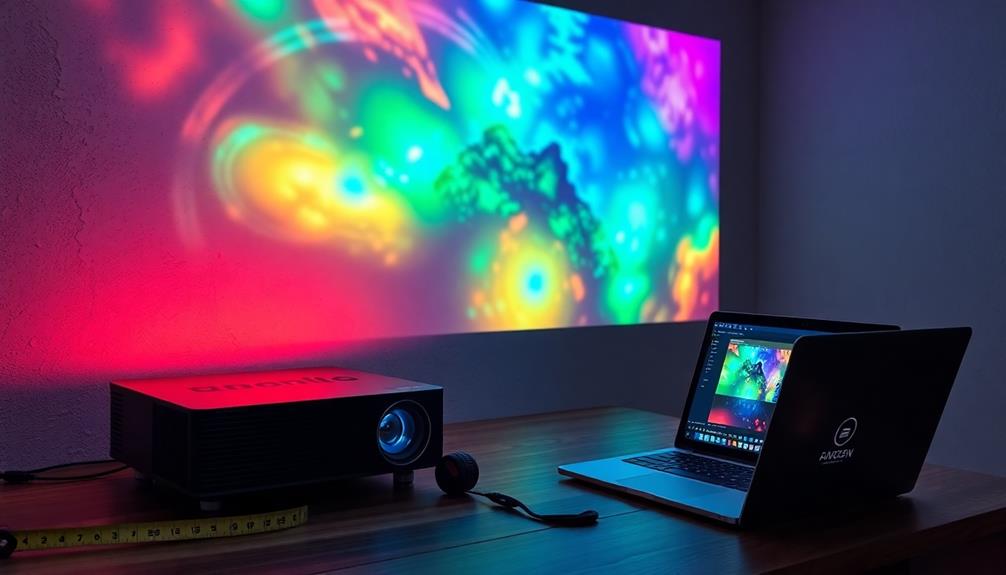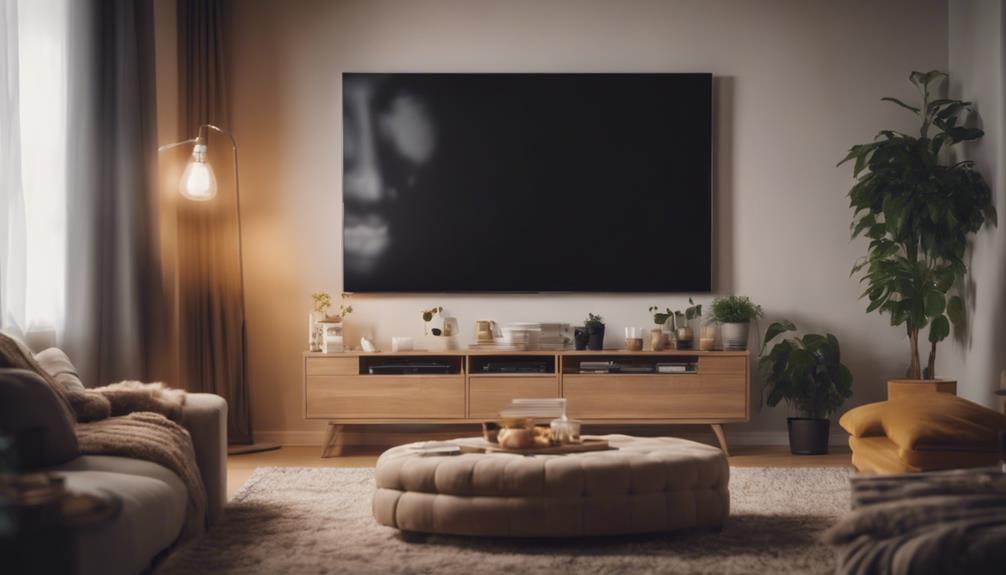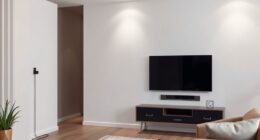When you're deciding between a projector and a TV for your home entertainment setup, think about your needs and space. Projectors offer a larger screen experience for less per inch but often require darker environments to shine. TVs, on the other hand, excel in brightness and color accuracy, making them ideal for well-lit rooms. They're also low-maintenance and come with built-in smart features. If you're focusing on cinematic experiences in a dedicated room, projectors could be a good fit, but for versatility and convenience, a TV might be your best bet. Discover what fits your lifestyle best!
Key Takeaways
- Projectors are ideal for large screen experiences in dark rooms, while TVs excel in bright environments with consistent image quality.
- TVs generally offer better image quality, especially with HDR content, compared to most projectors.
- Consider long-term costs: projectors require bulb replacements, while TVs typically have lower ongoing maintenance expenses.
- Projectors may have lower initial costs, but additional setup expenses for screens and audio can increase overall investment.
- Smart TVs provide built-in features and connectivity, reducing the need for extra devices compared to projectors.
Price and Value Analysis
Considering the price and value of projectors versus TVs for home entertainment reveals some key differences. When you look at the price tag, projectors often seem appealing, especially since they can provide a larger screen experience at a lower cost per inch—about 40% less than similarly sized TVs.
Additionally, investing in quality accessories like headphone amplifiers can further enhance your overall audio experience with projectors. However, keep in mind that while the initial projector costs might be lower, the overall setup cost can add up quickly. You'll likely need to invest in screens and audio equipment, which can inflate your budget.
On the other hand, big TVs have become more accessible due to significant price drops in recent years. This makes it easier for you to find a quality display without the added expenses that projectors might require.
Furthermore, ongoing expenses like bulb replacements for projectors can also affect the long-term cost of ownership. In contrast, TVs typically offer greater longevity, which enhances their value proposition.
Ultimately, while projectors can enhance your home theater experience, you should carefully weigh the initial costs against potential ongoing expenses before making a decision.
Image Quality Comparison
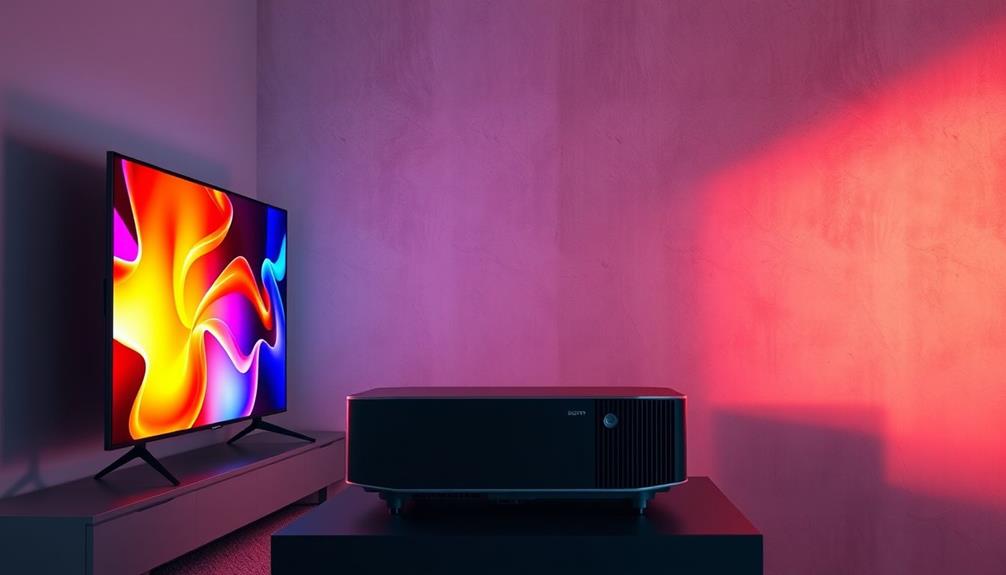
When it comes to image quality, the differences between projectors and TVs can considerably impact your viewing experience. OLED TVs stand out for their superior image quality, delivering deep blacks and vibrant colors that create exceptional contrast and overall fidelity.
If you're aiming for stunning visuals, TVs often outperform projectors in this area, especially regarding HDR (high dynamic range) content. Additionally, keyword clustering enhances SEO by grouping related keywords, which can also be applied to finding the best display technology for your needs.
Projectors typically struggle with brightness and contrast, particularly in well-lit rooms. Most affordable projectors can't achieve the necessary brightness levels or contrast ratios for ideal HDR experiences, which means dark scenes may appear washed out.
While projectors can range from 1,500 to 3,000 lumens, that often falls short in bright environments where TVs excel.
Recent advancements, like laser projectors, are closing this gap and can provide near-TV quality visuals, especially in controlled lighting. They may offer improved color reproduction and brightness, but higher-end models come at a premium price.
In the end, if you prioritize image quality and versatility in various ambient light conditions, a TV might be your best choice. However, projectors can still be viable with the right setup.
Environmental Impact

Weighing the environmental impact of projectors versus TVs reveals significant differences that can influence your choice for home entertainment.
Projector technology often requires darker environments to deliver the best performance, as ambient light can degrade the projected image quality. While projectors can be effective in dedicated home theaters, they struggle in well-lit spaces without additional enhancements like ambient light-rejecting screens—these can be pricey and still mightn't match the performance of a TV.
Additionally, considering the energy efficiency of your setup is important; for instance, geothermal energy systems can be a sustainable choice for powering your home, which complements the eco-friendly considerations of using low-energy devices like projectors sustainable practices in energy.
Conversely, TVs shine in various lighting conditions, producing brighter images that maintain quality even in daylight. This versatility means you won't have to invest in expensive screens or darken your room for ideal viewing.
However, consider the energy consumption as well: projectors typically operate with lower wattage compared to large TVs, especially when you factor in screen sizes.
Ultimately, your decision should weigh not just the technology but also the viewing environment. If you frequently watch in bright rooms, a TV's environmental impact may be less than that of a projector, which requires more effort and resources to achieve a satisfactory viewing experience.
TV Types and Features

In today's market, various TV types and features cater to different viewing preferences and needs. If you're looking for energy efficiency and bright displays, LED TVs might be your best bet for general viewing.
For those who crave cinematic experiences, OLED TVs deliver superior contrast with deep blacks and vibrant colors, making every scene pop. If you want a vivid viewing experience, consider QLED TVs, which use quantum dot technology to enhance brightness and color volume.
Additionally, many modern televisions now incorporate advanced audio technology, improving sound quality without the need for extra speakers, which can contribute to an immersive viewing experience. If you're also mindful of your budget, you can find excellent options that provide high performance without breaking the bank, especially in budget-friendly vacuum cleaners.
Smart TVs add another layer of convenience, integrating streaming services and internet connectivity, so you can easily access your favorite shows and movies without additional devices. If gaming is your passion, you'll want to explore gaming TVs, designed with low input lag and high refresh rates, optimized for an enhanced gaming experience on consoles.
With so many options available, you can find a TV that fits your specific needs, whether it's for binge-watching, gaming, or simply enjoying your favorite films. Understanding these TV types and features will help you make an informed decision for your home entertainment setup.
Market Trends and Preferences
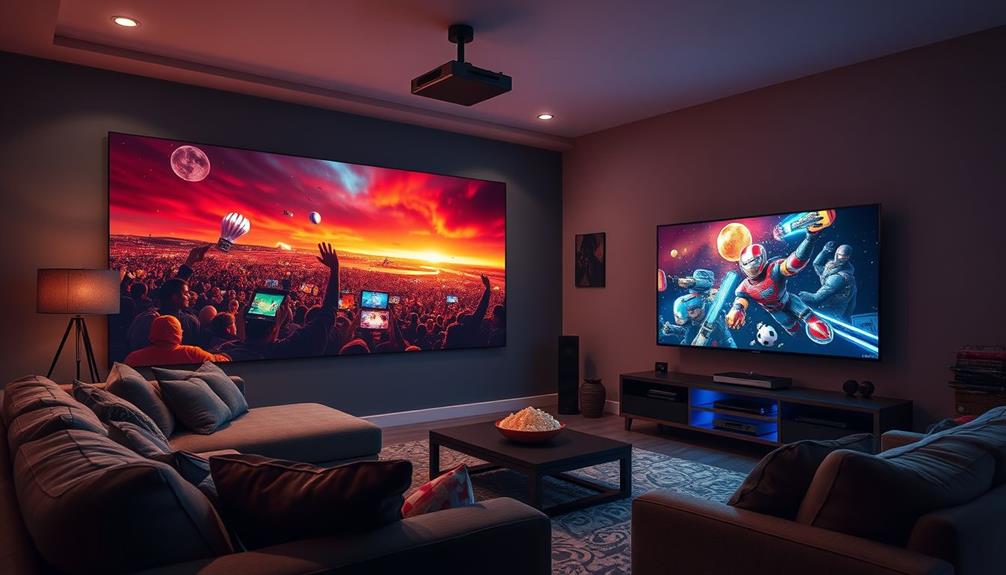
As you explore your home entertainment options, you'll notice a clear shift in consumer preferences toward TVs, thanks to their superior brightness and color accuracy.
This trend mirrors the advancements seen in other entertainment areas, such as animated films, where innovative storytelling and technology have elevated viewer experiences.
Technology advancements have made OLED and QLED TVs hard to beat, while projectors struggle to match their performance despite ongoing improvements.
When considering costs, larger screen sizes from projectors may offer savings, but the gap is narrowing as TVs continue to evolve.
Consumer Preference Shifts
While the landscape of home entertainment continues to evolve, consumer preferences are clearly shifting towards TVs over projectors. This change is largely driven by advancements in TV technology and the superior image quality they offer. High-performing OLED and QLED TVs provide vibrant colors and remarkable HDR capabilities, making them more appealing for everyday viewing.
Additionally, many consumers are now looking for investment options that provide both enjoyment and value retention, similar to how gold can diversify retirement portfolios.
Projectors, often seen as niche products, are typically reserved for dedicated home theater setups. However, most consumers favor the convenience and versatility of TVs for daily use. Price drops in large screen TVs have made them more accessible, allowing you to enjoy sizes that were once exclusive to projectors.
Moreover, TVs excel in various lighting conditions, performing well even in bright rooms. This practicality enhances their appeal, especially for those who want a flexible viewing experience without the need to darken the environment.
As consumer preference continues to lean towards TVs, it's clear that they offer a more user-friendly and versatile solution for home entertainment setups. If you're considering an upgrade, you might find that a quality TV suits your lifestyle better than a projector.
Technology Advancements Impact
With recent advancements in technology, the competition between projectors and TVs has intensified, particularly in the home entertainment market. Modern projectors offer impressive brightness and color accuracy, making them a strong contender for home theater setups.
However, TVs typically dominate due to their better image quality, especially with the rise of large OLED and QLED displays that enhance HDR capabilities. As AI advancements drive innovations in both projector and TV technologies, AI-driven solutions are refining viewing experiences and tailoring content delivery for consumers.
The ongoing trend toward smart TVs has also shifted consumer preferences. These all-in-one solutions integrate streaming services and provide user-friendly interfaces, making them more convenient for everyday viewing.
While projectors can support larger screen sizes at a lower cost per inch, the hassle of installation and the need for ideal lighting conditions can deter some buyers.
Nevertheless, innovations like ultra-short throw projectors have addressed these concerns, allowing you to enjoy a larger viewing experience in limited spaces without complicated setups.
As technology continues to evolve, the rivalry between projectors and TVs will likely shift further, catering to diverse preferences and enhancing home entertainment experiences.
Ultimately, your choice will depend on your specific needs, space, and how you prioritize image quality versus convenience.
Cost Comparison Insights
When evaluating the cost of home entertainment options, projectors often present a more economical choice for those seeking larger screens. The cost comparison reveals that projectors typically offer a lower cost per inch than large TVs, making them a budget-friendly option for expansive setups.
You can find modern projectors with impressive image quality for around $1,000, which is considerably cheaper than many large TVs. Additionally, it's vital to take into account the potential for customization options in your setup, which can enhance your viewing experience, similar to how one might approach selecting a home cleaning service.
However, it's important to factor in additional setup expenses. Projectors often require external audio systems and dedicated screens, which can raise your overall costs. High-quality 4K projectors can range from $2,480 to $2,999.99, representing a notable investment.
Many consumers find the convenience and built-in features of TVs worth their higher upfront costs. As market trends show a preference for TVs, driven by their brightness, color accuracy, and ease of use, it's important to weigh your specific needs.
If you prioritize large screen size and budget, projectors might be your best bet. But if you value convenience and performance, investing in a TV could prove more advantageous for your home entertainment setup.
Viewing Environment Considerations
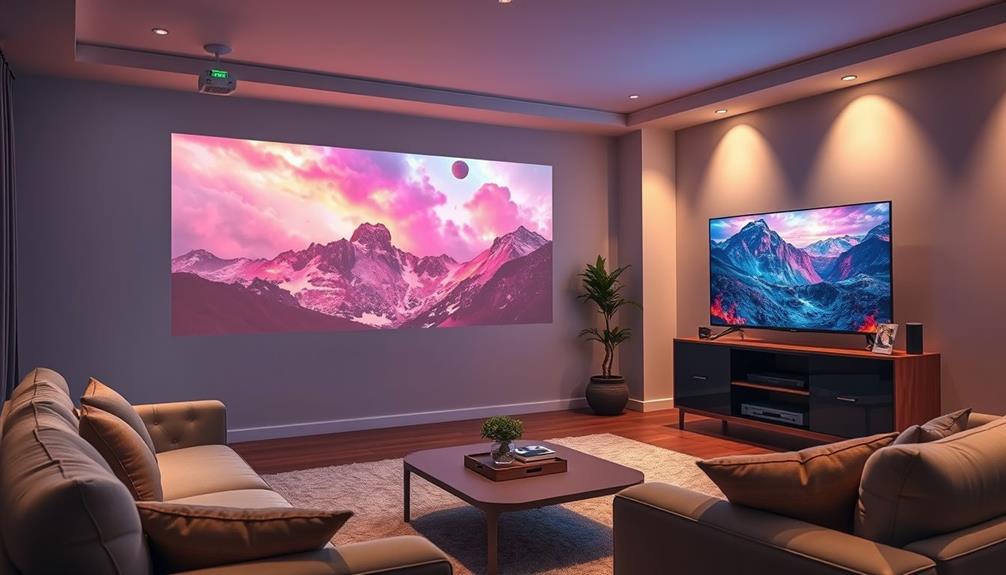
Evaluating your viewing environment is essential for deciding between a projector and a TV for home entertainment. If you plan to watch movies or shows in a dark room, a projector can deliver stunning image quality.
Additionally, incorporating modern technology like robotic pool cleaners can enhance your overall entertainment experience by allowing you to spend more time enjoying your space rather than maintaining it. However, keep in mind that projectors thrive in minimal ambient light. A brightness of at least 3000 lumens is usually necessary for daytime viewing, while TVs shine in brightly lit environments, providing clear images regardless of the ambient light.
If you opt for a projector, consider investing in blackout curtains or ambient light-rejecting screens to enhance performance. While these solutions can be effective, they might also come with a hefty price tag. On the other hand, TVs naturally produce brighter images, making them suitable for various lighting conditions.
Moreover, the room dimensions play a significant role in your choice. A larger screen can be more enjoyable from a distance, but a smaller room might limit your options.
Ultimately, understanding your specific viewing environment helps you make the best decision between a projector and a TV, ensuring you enjoy a satisfying home entertainment experience.
Budget and Setup Requirements
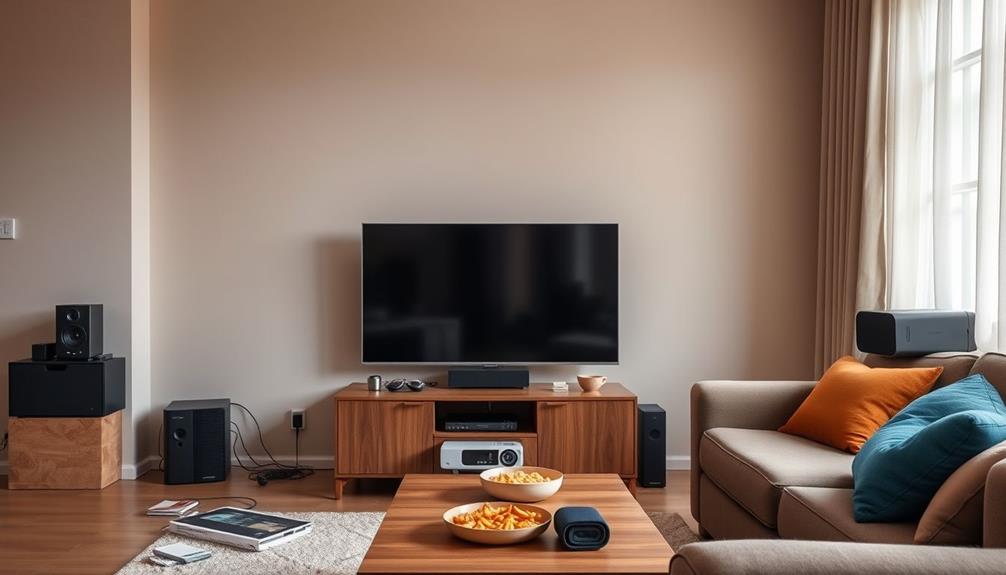
When considering budget and setup requirements, you'll want to weigh the initial costs of projectors versus TVs.
While projectors can be more affordable upfront, keep in mind the potential complexity of installation and ongoing maintenance expenses, like bulb replacements.
Additionally, understanding the importance of quality assurance in electronics can help you choose a reliable device that meets high standards.
TVs often simplify this process with built-in features, making them easier to set up and maintain over time.
Initial Costs Comparison
In the domain of home entertainment, comparing initial costs between projectors and TVs reveals some notable differences. Projectors typically have a lower initial purchase price than large TVs, averaging about 40% less per inch of screen size. You can find affordable projectors around $1,000, but remember that additional expenses for screens, mounts, and sound systems can greatly increase the overall setup cost.
On the other hand, TVs often come with built-in smart features, which can reduce the need for extra streaming devices and help lower your long-term costs. While budget-conscious consumers might find projectors more economical regarding screen size per dollar, ongoing expenses like bulb replacements must also be taken into account. These can add to the total cost of ownership over time.
If you choose a projector, you'll need to reflect on those extra investments required to optimize performance and audio quality.
Ultimately, the decision hinges on what you prioritize: upfront savings with projectors or the convenience and lower long-term costs of TVs.
Installation Complexity Levels
Setting up your home entertainment system can vary considerably between projectors and TVs, impacting both your budget and the complexity of the installation.
Projector setups can be economical, especially if you use white walls or budget-friendly screens. On the other hand, larger TVs often require a more significant upfront investment for quality models.
When it comes to installation complexity, ultra-short throw projectors simplify the process, allowing placement just inches from the wall. This reduces the need for extensive setup space or complex mounting.
Ceiling mounts for projectors offer an unobtrusive installation option, ensuring ideal image projection without interfering with your seating arrangements.
In contrast, wall mounting TVs necessitates precise measurements between the TV and the seating area, adding complexity to the installation process.
While professional installation services are available for both projectors and TVs, projectors may demand more specialized knowledge for ideal setup and configuration.
Ongoing Maintenance Expenses
Ongoing maintenance expenses can catch many home entertainment enthusiasts off guard, especially when choosing between a projector and a TV. Projectors often have higher ongoing maintenance costs due to bulb replacements, which can run between $100 and $300 every few years. This expense adds to the initial purchase costs and may also require investments in high-quality screens and sound systems, complicating your budget further.
On the other hand, TVs generally have lower ongoing maintenance costs, as they don't need bulb replacements. However, you might face occasional software updates or repairs. Here's a breakdown of potential costs for each option:
| Item | Projector | TV |
|---|---|---|
| Initial Purchase Costs | $500 – $2,500 | $300 – $3,000 |
| Ongoing Maintenance Costs | $100 – $300 (bulbs) | Minimal (updates) |
| Additional Accessories | High-quality screens, sound systems | Minimal (cables) |
| Long-Term Costs | Higher | Lower |
When budgeting, remember to factor in both the initial investment and potential long-term costs associated with maintenance and additional accessories.
Audio Quality Assessment
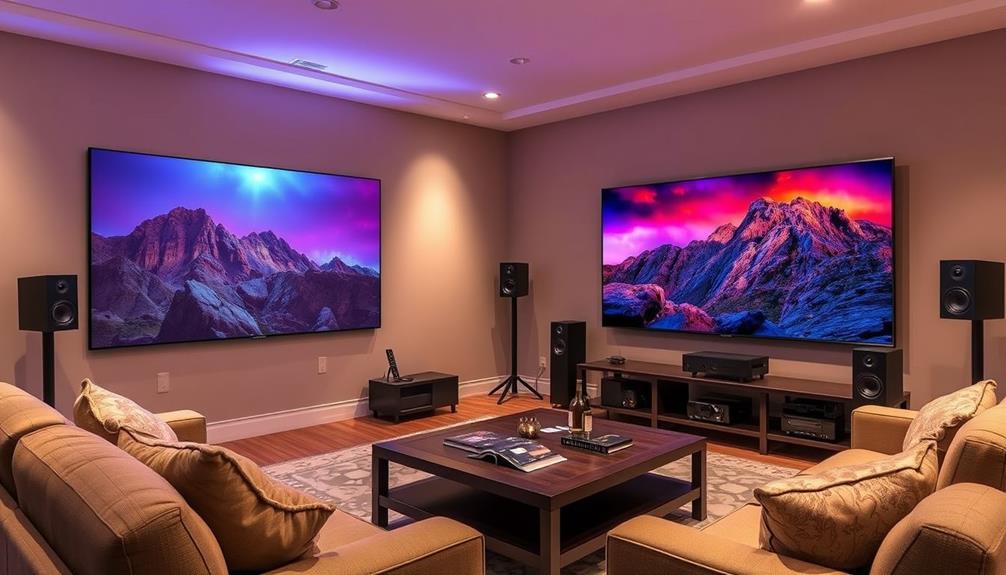
How do you measure the audio quality of projectors versus TVs?
When it comes to sound, both options have their strengths and weaknesses. You'll find that TVs generally provide superior sound quality with robust built-in speakers, making them user-friendly right out of the box.
In contrast, projectors often come with lower-quality built-in speakers, requiring you to invest in external sound systems for an ideal audio experience.
Here's what to evaluate:
- Built-in Speakers: TVs typically offer better built-in speakers, enhancing your immediate experience.
- External Sound Systems: For projectors, a soundbar or surround sound setup is essential to achieve that immersive experience.
- Sound Quality: High-quality audio systems, like 5.1 or 7.1-channel setups, can elevate both projectors and TVs.
- User Preference: If audio quality is a priority for you, TVs may be the more straightforward choice without additional investments.
Ultimately, your choice will depend on how much effort you're willing to put into achieving the best sound quality alongside visual performance for your home entertainment setup.
Outdoor Viewing Options
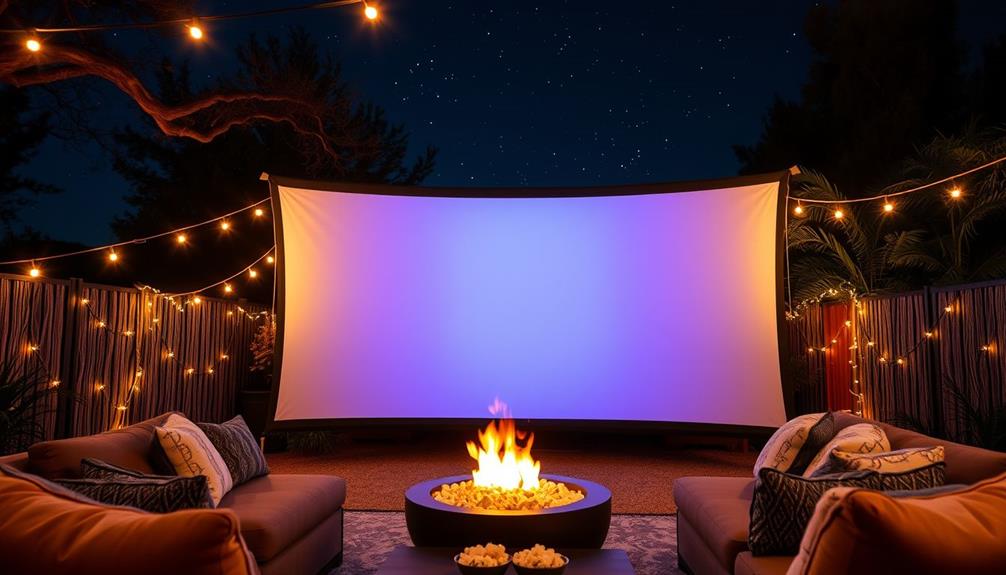
Outdoor viewing options bring a unique charm to movie nights, letting you enjoy films under the stars. For an unforgettable experience, outdoor projectors are a fantastic choice. They come in various screen sizes, typically ranging from 100 to 300 inches, allowing you to customize your setup as needed.
Many of these projectors are portable and easy to set up, making them perfect for impromptu gatherings.
To guarantee ideal image quality, you'll want to take into account the lighting conditions. Investing in ambient light-rejecting screens can greatly enhance visibility, especially during daylight, though they can be pricey.
For the best viewing experiences, look for projectors with at least 3000 lumens brightness. This will help maintain clear visibility in twilight or even daylight.
Don't forget about sound! Built-in speakers often fall short in larger outdoor spaces. To truly immerse yourself in the film, you should invest in a quality sound system that complements your projector.
With the right setup, your outdoor movie nights will be memorable and enjoyable for everyone involved.
Conclusion
In the grand showdown of projector versus TV, it's clear you're not just choosing a device; you're picking your entertainment identity. Will you bask in the glow of a massive image that rivals cinema, or cozy up to the familiar flicker of a flat screen? Remember, while projectors might make you feel like an avant-garde film aficionado, TVs are, after all, the reliable friends who show up at every binge-watching party. Choose wisely, or risk becoming a relic of the past!
